
Have you ever had a discussion with someone about the possibility of aliens existing on other planets? Don’t worry. This isn’t going to be a geeky post. But I am serious. Many people believe in the possibility that other life forms exist on other planets. Their major reason for this?
Well, if there are millions and millions of stars, then there must be billions of possible planets. Surely there are some that would harbor life.
Now, this is all conjecture and supposition. I don’t know the answer to this question. No one knows the answer to this question. But as I am studying more and more about our planet, I am learning that we are quite rare.

The conditions to support life as we know it are plentiful and very specific. Such as the size of our sun, Earth’s position within our solar system, the existence of huge, gas giant planets outside of our orbit, our perfectly designed atmosphere, including what it is made of and its existence, and even our solar system’s position within our galaxy. There are so many “required” parameters to support our life that if you assign numerical probability to all of them, the likelihood of another planet existing like ours is even smaller than the possible number of planets that exist!
We are rare!
Now, I am not saying that there is no life on other planets. I just don’t know that. And even if there was, it is God’s wisdom that upholds that life, and I believe it would be for his great purpose.
But I want you to realize the perfection of design of our unique little ball of Earth on which we live.
Here is just one amazing detail: Our sun is the perfect size and brightness to support life. A larger sun would be too hot and create way too much gravitational force. A smaller sun wouldn’t produce enough light for living things to survive on Earth, and it wouldn’t be able to hold many large planets in orbit around it. Well suns produce light, right? And you probably know that our sun produces a wide range of light wavelengths. Visible light is the light that we can observe with our eyes. It includes all the colors of light we see in a rainbow. But it represents only a tiny range of light waves that the sun makes. Radio waves, infrared waves, microwaves, and television waves are also produced by our sun. These waves have a lower energy than visible light. And they are useful to us, aren’t they?

But there are some rays our sun produces that are harmful to us. Ultraviolet rays, x-rays, and gamma rays have such a strong energy that living cells die when they are exposed to them in large amounts. So why aren’t we all being fried to pieces right now?
Simple. These three attackers to our Earth are protected by exactly three perfect lines of defense. You see, the Earth’s atmosphere is composed of lots of gases. And over 70 percent of the atmosphere is made up of nitrogen gas. We don’t need nitrogen gas for our body functions, but we DO need it to be at that perfect concentration in the air. Nitrogen gas doesn’t react with our bodies, but it behaves as a carrier to help us get the oxygen we need to survive. If there was a much higher concentration of oxygen in our atmosphere, our bodies would quickly overheat, and we would not live nearly as long. Oxygen causes metabolic functions to happen faster. And that is bad.
So we need just the right concentration of oxygen in our atmosphere. Twenty-one percent is perfect. And that is exactly what we have.
Well, back to the damaging light waves. Gamma rays are light waves that have the greatest energy and are the most damaging. But interestingly, nitrogen gas stops most of them before they reach the Earth. I won’t go into the chemistry behind it, but it is pretty fascinating how the way that nitrogen gas forms strong little molecules in air is the perfect configuration to stop gamma rays from hitting the earth.
X-rays have a little less energy, so they are unable to break up nitrogen gas and aren’t affected by its presence. But oxygen gas has the perfect molecular configuration to stop x-rays. And that is just what it does. Lastly, ultraviolet rays, the ones we are always warned about when going out in the sun, have a little less energy than x-rays, but they are still damaging to living tissue. Well, they are stopped by a third type of gas in our atmosphere: ozone. Ozone is made up of three oxygen atoms, and has the perfect molecular configuration for breaking up ultraviolet rays.
But ozone is poisonous to living things. So it “just so happens” to be located in a layer within our atmosphere that is higher than where living things are. Isn’t that amazing? We need it to protect our Earth, but we can’t have it where we are living. So instead of being mixed in with the other gases in our atmosphere in large concentrations, ozone exists high up above us, but still within our protective atmospheric layer.
All of these specific parameters I just mentioned need to exist or we would not be able to survive. And this is just one planetary requirement for life.
The “take home” on this? Earth is a unique planet located in a unique position in a unique solar system in a unique position in its galaxy.
Add to that our God who is continually upholding every single molecule He has created, completely intimate with our every move, every breath, every thought, and we can truly say with Colossians 1:17, “He is before all things, and in him all things hold together.”

